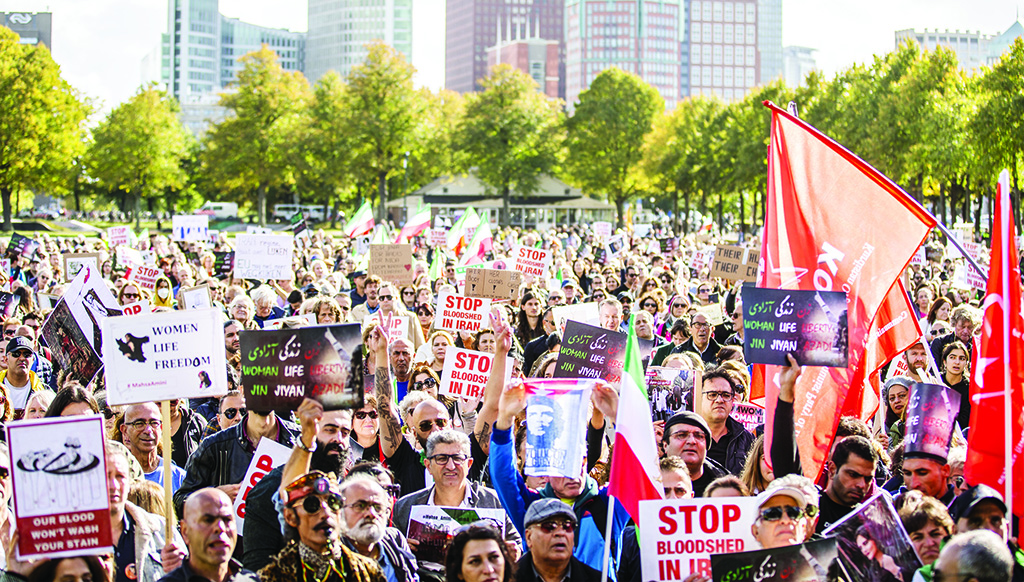TEHRAN: On an early autumn day in Tehran, the morality police arrested in a city park a 22-year-old Iranian woman who was in the capital on a family visit, bundled her into a van and drove her to the police station. The detention of Mahsa Amini on September 13 set in motion a chain of events that one month on has left Iran's clerical leadership under supreme leader Ayatollah Ali Khamenei, 83, facing one of its biggest challenges since the 1979 Islamic Revolution but whose final outcome remains far from certain.
Amini's arrest was an ordeal shared by hundreds of women every year who are deemed to have fallen foul of the Islamic republic's strict dress rules imposed after the fall of the shah. But less than two hours after her arrest and transfer to the Vozara detention centre, Amini was in a coma. Rushed to Kasra hospital, she was pronounced dead on September 16. Her family and lawyers believe she was dealt a fatal blow to the head in custody.
Protests started outside the hospital on September 16 after the announcement of her death. Her funeral in her home province of Kurdistan on September 17 turned into a protest action with the movement spreading nationwide. One month on, Iran's leadership is still facing what has proven to be the most enduring, taboo-breaking and multifaceted protest movement in the Islamic republic's history as well as the first driven by women.
The leaderless protest movement as yet shows no sign of dwindling, with protests not just on the streets but at universities, schools and even oil refineries. But the regime is also willing to use levers of repression extending to lethal force, internet shutdowns and mass arrests.
While the protests could mark "the beginning of the end of the Islamic republic" they would need to be sustained and find some kind of leadership structure, said Cornelius Adebahr, nonresident fellow at Carnegie Europe. "It just takes a lot more than continued street protests and calls for sanctions for positive change to set in," he said.
'Overthrow outright'
The protests built on existing disenchantment over economic hardship and corruption that had already caused demonstrations in the past. They have taken place in Tehran, the northern hub of Tabriz, the historic cities of Isfahan and Shiraz, the pilgrimage city of Mashhad that is Khamenei's home region, and the Caspian Sea provinces.
Iran has seen protest waves in recent years -- notably in 2009 over disputed election results and in 2019 over a sudden energy price hike -- but none that have so blatantly challenged the foundations of the Islamic republic set up in 1979 by Ayatollah Ruhollah Khomeini. "The uprising started as a response to the restrictions on women's dress and behaviour in public... but has evolved into a campaign to overthrow the regime outright," said the US-based Soufan Center think-tank.
Anti-regime slogans such as "Death to the dictator" are not entirely new in Iran but never have they been used so frequently. Women have removed and even burned headscarves. Images of Khamenei and icons of the regime, like late Revolutionary Guards commander Qasem Soleimani, have been defaced or set on fire.
Videos have shown protesters pushing back against security forces, evading arrest, burning police cars and on occasion even setting up roadblocks. The deaths of young women in the protests such as Nika Shahkarami and Sarina Esmailzadeh, both 16, whose families say were killed by the security forces, have created new protest icons along with Amini.
The protests have also smashed any notion of Iranian politics as a battle between so-called reformist and conservative elements working within the system and also switched international attention away from talks with Iranian leaders on the nuclear programme. "The protesters have changed the dominant discourse by mandating for a real change. They say no to the entire political regime," said Shadi Sadr, director of the Justice for Iran UK-based NGO.
She said the current protests were "much larger in scale and lasted much longer" than in 2019 when fewer cities were involved, including Tehran, and protesters mainly came from lower social classes. It's "time to think beyond the Islamic republic", said Roham Alvandi, an associate professor of London School of Economics, declaring that "reform is dead".











